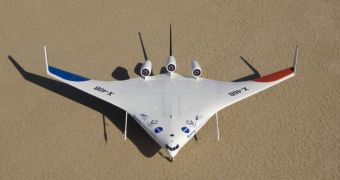The American space agency announces the awarding of two new research contracts, which deal with the design and development of concepts that will holds relevant for the aeronautics industry of tomorrow.
NASA is looking for ideas on how to go about constructing the next generation of advanced airliners, crafts that would fly more silently, and also be more fuel efficient, than today's most advanced ones.
Reducing fuel consumption and greenhouse gases emission levels is something that the aviation industry is striving for, given that the implementation of international legislation to curb GHG emissions is inevitable.
Even though they pay lobbyists to delay the process, all airlines are aware that it this will be done a few years from now. As such, they are also looking for new designs that will comply with future legislation.
In the approach the space agency took, it calls for companies to develop airliner designs that could be transferred into tangible reality, and put into service, by as early as 2025.
From the companies that applied for the new grants, NASA selected Palmdale, California-based Lockheed Martin and El Segundo, California-based Northrop Grumman as the winners.
Lockheed received a $2.29 million contract, whereas Northrop got a $2.65 million one. The companies' respective projects begin this November, and will end up 12 months from now, in November 2011.
For the design research stage, the agency set forth a series of noise, emissions and fuel burn reduction goals that both companies need to meet with their respective proposals.
What NASA is interested in learning is whether all these requirements can successfully be integrated into a single flight platform. It is also looking to ensure that the technological elements needed for future airlines exist, and are feasible to use.
The airplanes need to be able to carry between 50,000 and 100,000 pounds, either in the form of passengers or cargo, at speeds reaching 85 percent that of sound, SpaceRef reports.
They also need to have an average range of about 7,000 miles, which would eliminate the need for detours along the way. Airport pit stops are responsible for the emissions of large amounts of GHG.
Given the environmentally-friendly aspect of the study request, the investigations are funded by the NASA Environmentally Responsible Aviation Project.
The main demands listed in the request are reducing emissions and fuel consumption by 50 percent from current levels, and reducing the number of regions subjected to high levels of airport noise by as much as 83 percent.

 14 DAY TRIAL //
14 DAY TRIAL //